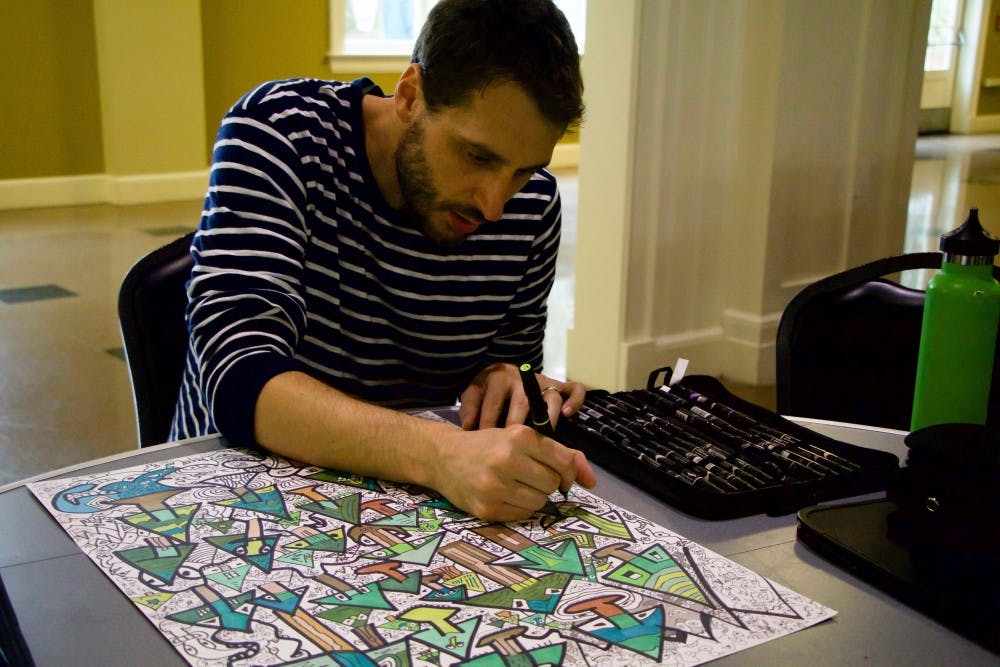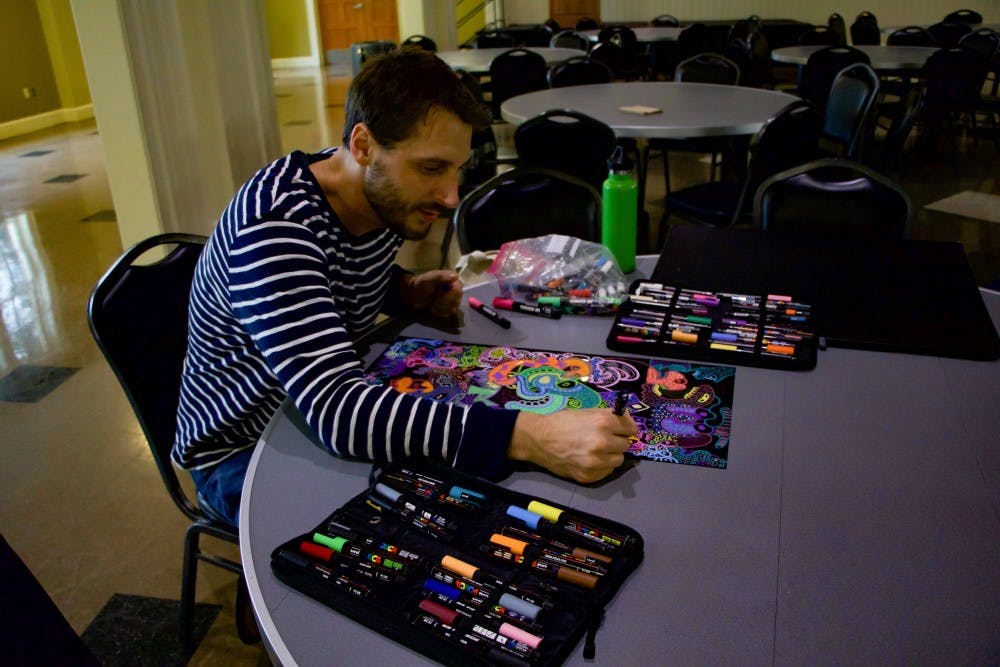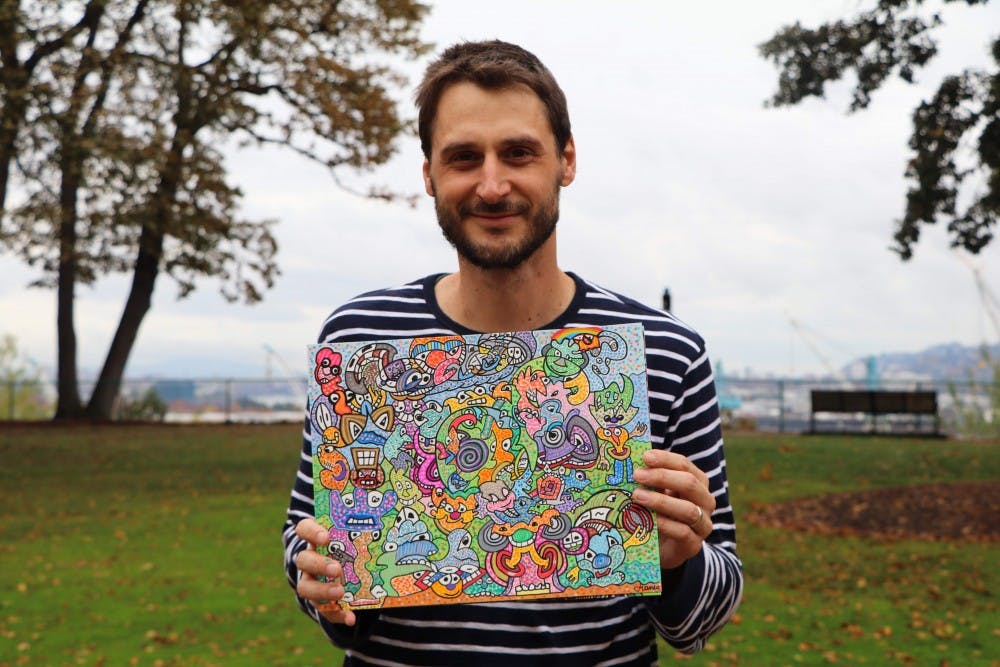A year and a half ago, if you asked history professor Brad Franco about art, he would have said that he was bad at it. Though he is talented at playing and writing music, drawing and painting were never for him.
“Art was always the thing I was worst at my whole life,” Franco said.
Fast forward to today, and his art Instagram account, which is devoted to sharing his psychedelic-style drawings and paintings, has over ten thousand followers. He even sells some of his artwork through his account.
Franco’s artistic journey began less than 15 months ago. Since then, he has developed both his artistic abilities and his fame, showing that it is never too late to discover a new talent.
Franco, an associate professor of history at UP, discovered his artistic abilities while traveling on an airplane during a family trip in July of 2017. Franco doodled something after his daughter requested a drawing. To his surprise, the drawing wasn’t half bad. Franco’s wife, a graphic designer, saw artistic potential and encouraged him to do it again.
With these first few doodles, Franco realized that he may be onto something.
“I’m not terrible at this thing,” Franco said of when he first discovered his talent. “This is something I can explore.”

Franco concentrates as he works on one of his art pieces.
The discovery of his drawing ability also coincided with the start of a year-long sabbatical from teaching history courses at UP. His sabbatical was a time for taking a step back and spending time in reflection and self-discovery. While his year was spent doing some research, it also provided Franco with more time to explore his new hobby.
Franco described his artistic style as psychedelic. Around the same time he started drawing, he was listening to new kinds of music including psychedelic rock from Australia. He has also been writing and recording music since he was 14 years old, much of which falls under the psychedelic rock genre. This new music gave him moments of clarity and showed him that art doesn’t need to make total sense — a lesson he carried with him as he began creating his own artwork.
Each piece of Franco’s art is intentionally different from the others. He views each piece as an opportunity to try a new thing. Franco also stressed that there is a lot more going on in his artwork than what you may originally see.
“Part of art is the ability to convey the ineffable, the things that are hard to express,” Franco said.
His art pieces often deal with broader themes like greed, fraud and gender, as well as life’s biggest questions like who we are and what makes us tick. Franco, a historian by trade, brings in his understanding of history and topics he discusses in his courses.
While teaching about Dante’s “Inferno” in his Foundations of Western Civilization course, Franco discussed fraud, which became the focus of multiple artworks. Franco noted that it is often after he completes a piece when he is able to figure out the story or significance.
Franco realized that the process of making art allows a lot of time for thinking and reflection, which was appropriate for his sabbatical. Often, there is an unconscious part of his mind that makes the art for him, he said.
“My hand is moving and I don’t know what I am drawing or where this is going,” Franco said. “You start to trust your unconscious self. The key for you is to get out of the way.”
In those first few months of drawing, Franco would often lose himself in this creative experience.
“The first month, every time I made something, I would not be able to believe that I made it,” Franco said. “Because, central to my identity, the one thing I was terrible at in life was art. And to suddenly be able to make things that I think are cool, and other people think are cool. Honestly I had fear that I would lose this ability. It was like a superhuman magic power.”
Mark Pitzer, an associate professor of psychology at UP, attested to Franco’s magic power. Pitzer and Franco originally became friends by bonding over their shared interest in music. Franco plays guitar, piano and bass. He also sings and has recorded hundreds of songs.
Pitzer was originally shocked by Franco’s ability to make music so quickly, and was equally impressed with artistic talent and how quickly he could produce pieces.
“It wasn’t a drop. It wasn’t coming out of a spicket. It was coming out of a firehose,” Pitzer said. “It just never stops.”
Pitzer, a neuroscientist, was curious if there was anything he could learn from Franco’s work from a neurological perspective. He explained that our genes affect our ability to learn new skills to some level. But then we need to consistently practice to develop the skill.
Because Franco generates artwork so quickly and practices his skill with each new piece, he is able to make significant improvements at a rapid pace.
“He goes at it almost like a mixture of a job, and a passion, and an addiction,” Pitzer said. “I can only imagine grand things. With that much practice and that much interest, good things can happen.”
In addition to his skill level, Franco has also significantly grown his Instagram following. Ten and half thousand followers is a big deal. Franco based most of his big following on simple luck. He pointed out that there are so many other artists on Instagram who have, arguably, better work but don’t get famous.
Franco believes that his unique perspective of art attracts more followers. He thoughtfully crafts each caption of his photos, discussing the themes, messages and historical connections in his art. He thinks that his following comes just as much from the thought that goes into the posts as it does from the photos of his artwork.
Franco also credited his wife, who encouraged him to make his account more professional by taking high-quality photos and investing in high-quality materials. His posts also include numerous hashtags to increase visibility around Instagram.
In the early days of his Instagram account, Franco began hashtagging his favorite bands, including King Gizzard and the Wizard Lizard, which has a cult-following fan base. These hashtags attracted other fans of the band, some of whom reached out asking Franco to create art for them.
At one point, as he was growing his Instagram following, another account stole a photo of his artwork and posted it without his credit. While frustrating at the time, it actually worked out beautifully, Franco said. Strangers began to defend him in the comments, and all of the commotion ultimately drew more attention to Franco’s account.
Instagram has become a sort of self-chosen community for Franco. He enjoys sharing his ideas with a different audience than his normal classroom audience.

Franco uses acrylic paint markers on black acid-free poster board to create one of his pieces.
Instagram has also allowed Franco to sell some of his artwork. He runs an Etsy shop, but admitted that it is a bit outdated and that most of his sales come from Instagram. While he does not advertise it in his posts, he occasionally receives direct messages on Instagram asking to purchase certain pieces or asking for commissions.
Franco has completed more than 150 pieces in total, and he has sold about 15 of them. Franco is clear, however, that art is his hobby, not his job, and finds it much more enjoyable when he does not have to worry about selling his pieces. Since he is not reliant on his art to make money, he can spend as long as he wants on one piece.
Despite making so much progress since beginning his art career, Franco is nowhere near done.
“I don’t, in any way, think that I’ve reached the end of this journey,” he said. “It's an ongoing process of learning new techniques, new strategies, becoming better at drawing, better with color. Each piece presents new challenges and opportunities and things to learn.”
For Franco, the most profound lesson he’s learned is to stay open to discovering new talents, interests and hobbies.
“We often, by the time we are done with college, have a fairly fixed identity — who you are, what you like and what you’re good at,” Franco said. “Don’t narrowly define yourself, stay open to self discovery, to discovering you are good at things you had no idea you were good at or you were sure you were bad at... Don’t shut down potential avenues. You may surprise yourself.”
Franco’s artwork will be on display in the Buckley Center Gallery from Jan. 7 to Feb. 7.
Autumn Fluetsch is reporter for The Beacon. She can be reached at fluetsch20@up.edu.








